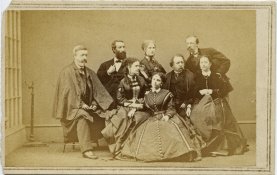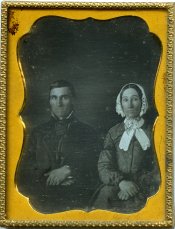http://dcphotoartist.wordpress.com/2011/11/28/new-additions-to-the-collection/
I posted some new images in my collection on my blog, and I'd love to get some feedback on folks' thoughts about them. I've been finding these images in various places from antique shops to eBay. Lately I've been finding images with really interesting/odd compositions that have me scratching my head as to what was going on in the photographers' head when they were taken. The daguerreotype I kinda get, but it still looks like something that should have been shot as a horizontal composition to more fully fill the frame with the sitters. As composed, it feels more post-modern than Victorian, intended to be deadpan/ironic. Is this just a less-than-skillful composition, or is it a flash of brilliance one hundred and sixty plus years early?

The carte-de-visite came from Alexander Gardner's studio in Washington DC - this was hardly a run-of-the-mill, anonymous generic wet plate portraitist traveling through the hinterlands doing penny-pictures. The head clamp visible in the corner of the room would seem sloppy and casual, and it would be understandable that it could be left in by accident at some other lesser studio. But there it is, in the corner, and sufficiently distinct from the group that it calls attention to itself. This says to me it was intentional, and that it was acceptable to the sitters because it was left in despite the fact that there are eight customers who would have to be pleased with it. I've seen the feet of head clamps showing in other CDVs I have before, or even a smidge of the head-clamp peeking out from behind an ear or the curve of a neck before, but never the entire clamp, so blatantly positioned and unused. Seeing it here to me would be like seeing a light stand, flash head and umbrella in a Monte Zucker portrait. Does anyone have any insight on this? Is my take completely off-base, or is there some historical fact that I'm missing?

I posted some new images in my collection on my blog, and I'd love to get some feedback on folks' thoughts about them. I've been finding these images in various places from antique shops to eBay. Lately I've been finding images with really interesting/odd compositions that have me scratching my head as to what was going on in the photographers' head when they were taken. The daguerreotype I kinda get, but it still looks like something that should have been shot as a horizontal composition to more fully fill the frame with the sitters. As composed, it feels more post-modern than Victorian, intended to be deadpan/ironic. Is this just a less-than-skillful composition, or is it a flash of brilliance one hundred and sixty plus years early?

The carte-de-visite came from Alexander Gardner's studio in Washington DC - this was hardly a run-of-the-mill, anonymous generic wet plate portraitist traveling through the hinterlands doing penny-pictures. The head clamp visible in the corner of the room would seem sloppy and casual, and it would be understandable that it could be left in by accident at some other lesser studio. But there it is, in the corner, and sufficiently distinct from the group that it calls attention to itself. This says to me it was intentional, and that it was acceptable to the sitters because it was left in despite the fact that there are eight customers who would have to be pleased with it. I've seen the feet of head clamps showing in other CDVs I have before, or even a smidge of the head-clamp peeking out from behind an ear or the curve of a neck before, but never the entire clamp, so blatantly positioned and unused. Seeing it here to me would be like seeing a light stand, flash head and umbrella in a Monte Zucker portrait. Does anyone have any insight on this? Is my take completely off-base, or is there some historical fact that I'm missing?

Last edited by a moderator:





